民航乘务英语考试大纲
中国民航乘务英语等级考试

中国民航乘务英语等级考试The Civil Aviation English Proficiency Test (CAEPT) is an important assessment for cabin crew members in China. This test evaluates the English language proficiency of flight attendants, ensuring that they can communicate effectively with passengers and crew members during flights. The CAEPT is divided into three levels: Basic, Intermediate, and Advanced. Each level assesses different aspects of English language skills, including listening, speaking, reading, and writing.The Basic level of the CAEPT focuses on simple English language tasks that are relevant to the duties of cabin crew members. This level assesses the ability to understand and respond to basic instructions, announcements, and conversations in English. Flight attendants at this level should be able to communicate effectively with passengers in routine situations, such as greeting passengers, providing safety instructions, and responding to basic inquiries.The Intermediate level of the CAEPT builds upon the skills tested at the Basic level and requires flight attendants to demonstrate a higher level of English proficiency. At this level, cabin crew members should be able to handle more complex communication tasks, such as dealing with emergencies, resolving conflicts, and providing detailed information to passengers. Flight attendants at the Intermediate level should also be able to understand and respond to a wider range of English language materials, such as safety manuals, announcements, and written instructions.The Advanced level of the CAEPT is the highest level of proficiency and is designed for flight attendants who need to communicate in English with a high degree of accuracy and fluency. At this level, cabin crew members should be able to handle complex communication tasks, such as giving detailed safety briefings, conducting in-depth conversations with passengers, and responding to challenging situations in English. Flight attendants at the Advanced level should also be able to understand and produce a wide range of English language materials, including technical documents, reports, and official communications.In order to pass the CAEPT at any level, flight attendants must demonstrate proficiency in all four language skills: listening, speaking, reading, and writing. They must be able to understand and respond to spoken English, communicate effectively in English, read and comprehend English language materials, and write clear and coherent English texts. Flight attendants who pass the CAEPT at the Basic, Intermediate, or Advanced level will receive a certificate of proficiency, which is valid for two years.Overall, the CAEPT is an essential assessment for cabin crew members in China, as it ensures that flight attendants have the necessary English language skills to perform their duties effectively and communicate with passengers and crew members during flights. By successfully completing the CAEPT at the Basic, Intermediate, or Advanced level, flight attendants can demonstrate their proficiency in English and enhance the safety and efficiency of air travel.。
空乘英语面试内容
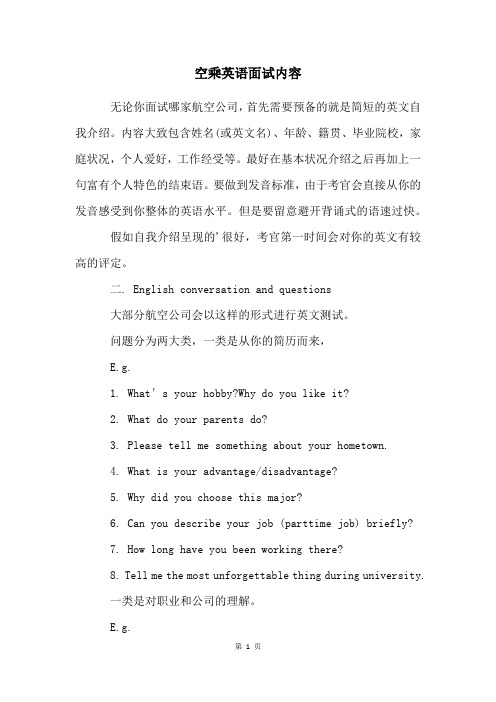
空乘英语面试内容无论你面试哪家航空公司,首先需要预备的就是简短的英文自我介绍。
内容大致包含姓名(或英文名)、年龄、籍贯、毕业院校,家庭状况,个人爱好,工作经受等。
最好在基本状况介绍之后再加上一句富有个人特色的结束语。
要做到发音标准,由于考官会直接从你的发音感受到你整体的英语水平。
但是要留意避开背诵式的语速过快。
假如自我介绍呈现的'很好,考官第一时间会对你的英文有较高的评定。
二. English conversation and questions大部分航空公司会以这样的形式进行英文测试。
问题分为两大类,一类是从你的简历而来,E.g.1. What′s your hobby?Why do you like it?2. What do your parents do?3. Please tell me something about your hometown.4. What is your advantage/disadvantage?5. Why did you choose this major?6. Can you describe your job (parttime job) briefly?7. How long have you been working there?8. Tell me the most unforgettable thing during university.一类是对职业和公司的理解。
E.g.1. Why do you want to be a cabin attendant?2. What do you think of cabin attendant?3. Why do you want to work for ****(Airline)?4. What do you know about ****(Airline)?5. Have you ever taken our company′s interview?假如听不懂问题,可以礼貌的请考官再说一遍,但是全程要保持微笑,没关系张和尴尬。
民航专业英语考试
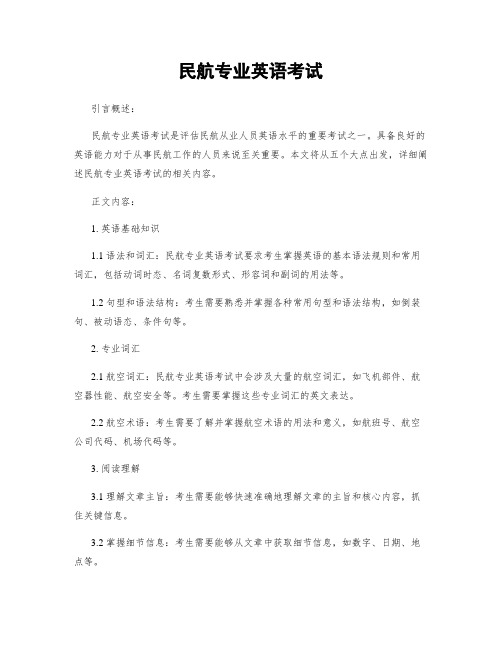
民航专业英语考试引言概述:民航专业英语考试是评估民航从业人员英语水平的重要考试之一。
具备良好的英语能力对于从事民航工作的人员来说至关重要。
本文将从五个大点出发,详细阐述民航专业英语考试的相关内容。
正文内容:1. 英语基础知识1.1 语法和词汇:民航专业英语考试要求考生掌握英语的基本语法规则和常用词汇,包括动词时态、名词复数形式、形容词和副词的用法等。
1.2 句型和语法结构:考生需要熟悉并掌握各种常用句型和语法结构,如倒装句、被动语态、条件句等。
2. 专业词汇2.1 航空词汇:民航专业英语考试中会涉及大量的航空词汇,如飞机部件、航空器性能、航空安全等。
考生需要掌握这些专业词汇的英文表达。
2.2 航空术语:考生需要了解并掌握航空术语的用法和意义,如航班号、航空公司代码、机场代码等。
3. 阅读理解3.1 理解文章主旨:考生需要能够快速准确地理解文章的主旨和核心内容,抓住关键信息。
3.2 掌握细节信息:考生需要能够从文章中获取细节信息,如数字、日期、地点等。
3.3 推理判断能力:考生需要根据文章内容进行推理判断,理解作者的观点和意图。
4. 听力理解4.1 听取关键信息:考生需要能够听取并理解关键信息,如航班信息、机场指示等。
4.2 掌握口音和语速:考生需要适应不同的口音和语速,确保准确理解对话内容。
4.3 掌握听力技巧:考生需要掌握一些听力技巧,如预测答案、注意关键词等。
5. 写作能力5.1 书面表达:考生需要具备良好的书面表达能力,包括写作格式、语法和词汇的正确运用等。
5.2 写作思路清晰:考生需要能够清晰地表达自己的观点和意见,组织合理的段落结构。
5.3 文章连贯性:考生需要注意文章的连贯性和逻辑性,确保文章内容的一致性和完整性。
总结:民航专业英语考试对于从事民航工作的人员来说具有重要意义。
通过掌握英语基础知识、专业词汇,提高阅读和听力理解能力,以及良好的写作能力,考生可以更好地应对民航专业英语考试,并在实际工作中有效运用英语。
《 民航空乘英语》9

Part
Part
1
Warm Up
2
Announcements
3
Dialogues in Cabin
4
Reading and Writing
1
The items chosen from the Arrival Card1 are listed below. Choose their appropriate2 explanations.
distributed to every passenger. If you have any question about completing the The forms will soon be ____________
forms, please ask the cabin attendants for help. They will be very happy to assist you.
Unit 9
Entry Form Filling
4
Items:
1. Sex3 (Male4 or Female5) 1. b 2. f 5. g 2. Passport No. 3. Country Where You Live 4. City Where You Boarded 5. City Where Visa6 Was Issued7 6. Date Issued (DD/MM/YY) 7. Address While in the United States (Number and Street)
Unit 9
Entry Form Filling
12
Long Announcements
2
Read the announcement and then choose the best answer for each question by “√”.
民航乘务英语考试大纲

民航乘务英语考试大纲 work Information Technology Company.2020YEAR中国民航英语工程乘务英语考试大纲(试行)中国民航总局2001年10月第一章考试总则第一节考试性质民航乘务专业英语考试是由中国民用航空总局组织, 对民航系统内乘务人员的正规英语水平考试.第二节考试目的民航乘务人员的英语水平直接影响着中国民航的服务质量, 影响着中国民航的对外形象, 民航乘务专业英语考试的目的是用考试的方法促进民航乘务人员英语水平的提高, 也为各航空公司安排乘务工作时提供考察乘务人员英语水平的参考依据.第三节考试对象民航乘务专业英语考试的对象是中国民航系统内的在职乘务人员以及高校乘务专业的毕业学生.第四节考试内容民航乘务专业英语考试的内容涉及乘务员素质、机上设施、航前航后准备、机上娱乐、餐饮服务、危险品处置、客舱服务、紧急情况处理、机场设施、海关、检疫等方面的知识。
语言范围主要是基础知识. 内容如下:1.各级考生需掌握的相关的阅读和听说的词汇量. 分别为:初级------2000/1500中级------3500/25002.语音语调基本正确。
3.词法:某些词的词形变化、各类词的作用和构成.4.句法:简单句、并列句、复合句及各种从句。
5.动词:动词的基本时态、非谓语动词(不定式、动名词、现在分词、过去分词)的形式及其作用。
6.形容词和副词的三种级别的用法。
7.虚拟语气。
第五节考试重点一.理解能力1.能正确理解原文, 掌握所读材料的主旨和大意.2.根据所读材料进行一定的判断, 推理和引申.3.既理解个别句子的意义, 又理解上下文之间的逻辑关系.4.领会作者的观点和态度.5.能根据原文正确做出各种练习.二.运用能力1.能正确运用自己的基础知识完成各类试题.2.能听懂考试要求内容并能正确表达自己的观点.第六节考试等级民航乘务专业英语考试根据考试重点和难度设两个等级: 初级和中级.第七节考试形式民航乘务专业英语考试的两个等级均设笔试, 听力, 口试三种形式. 各级的具体考试形式如下:一. 笔试(100分)初级考试:100分1. 词汇句法题量20句. (20%)2.阅读理解题量4段20题. (40%)3.完形填空题量10个空(20%)4.英译汉题量8句(20%)中级考试:100分1. 词汇句法题量20句. (20%)2.阅读理解题量4段20题. (40%)3.完形填空题量10个空(20%)4.英译汉题量8句(20%)二.听力与口语(100分)I.听力初级考试:60分1.辨音数字题量10个音标.(10%)2.单句选择题量10句. (10%)3.简单对话题量10段. (20%)4.短文题量2篇10题(20%)中级考试:60分1.数字题量10个. (10%)2.单句选择题量10个. (10%)3.简单对话题量10个. (20%)4.简单文章题量2段10题(20%)II.口语初级考试:40分1.自我介绍(5分)2.广播词朗读题量1段(15分)2.简单对话题量10题(20分)中级考试:40分1.自我介绍(5分)2. 按要求编播广播词题量1段. (15分)3.回答问题题量8个(20分)第八节考试用时一.笔试初, 中级两个级别笔试的规定时间均为90分钟.二.听力初级听力考试的规定时间为30分钟.中级听力考试的规定时间为30分钟.三.口试初级口试的规定时间为20分钟.中级口试的规定时间为20分钟.第九节考试方法初、中级的笔试均为书面答题. 所在答案必须写在答题纸上.听力为听录音并书面答题, 均需将答案写在答题纸上.口试均采用人机对话的方式进行.第十节阅卷每次考试结束后,由总局人教司或人教司委派某管理局科教部门监督阅卷。
民航英语2复习纲要二
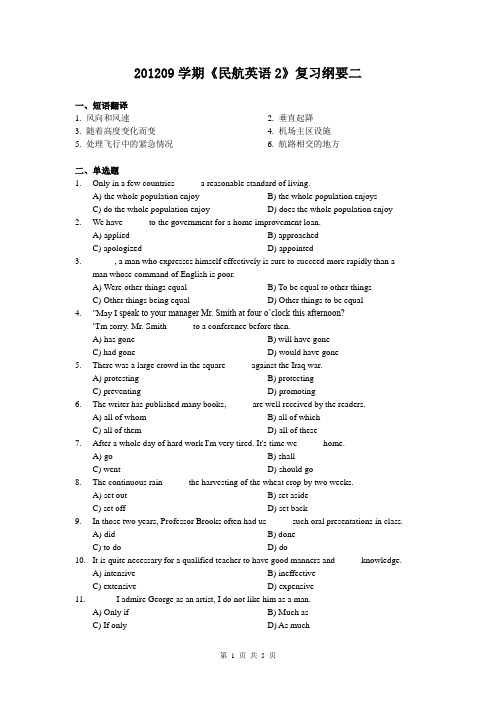
201209学期《民航英语2》复习纲要二一、短语翻译1. 风向和风速2. 垂直起降3. 随着高度变化而变4. 机场主区设施5. 处理飞行中的紧急情况6. 航路相交的地方二、单选题1. Only in a few countries _____ a reasonable standard of living.A) the whole population enjoy B) the whole population enjoysC) do the whole population enjoy D) does the whole population enjoy2. We have _____ to the government for a home improvement loan.A) applied B) approachedC) apologized D) appointed3. _____, a man who expresses himself effectively is sure to succeed more rapidly than aman whose command of English is poor.A) Were other things equal B) To be equal to other thingsC) Other things being equal D) Other things to be equal4. "May I speak to your manager Mr. Smith at four o’clock this afternoon?"I'm sorry. Mr. Smith _____ to a conference before then.A) has gone B) will have goneC) had gone D) would have gone5. There was a large crowd in the square _____ against the Iraq war.A) protesting B) protectingC) preventing D) promoting6. The writer has published many books, _____ are well received by the readers.A) all of whom B) all of whichC) all of them D) all of these7. After a whole day of hard work I'm very tired. It's time we _____ home.A) go B) shallC) went D) should go8. The continuous rain _____ the harvesting of the wheat crop by two weeks.A) set out B) set asideC) set off D) set back9. In those two years, Professor Brooks often had us _____ such oral presentations in class.A) did B) doneC) to do D) do10. It is quite necessary for a qualified teacher to have good manners and _____ knowledge.A) intensive B) ineffectiveC) extensive D) expensive11. _____ I admire George as an artist, I do not like him as a man.A) Only if B) Much asC) If only D) As much12. The ceremony is not for the _____ of the dead, but for the comfort of the living.A) respect B) purposeC) sake D) impression13. Criticism and self-criticism is necessary _____ it helps us to correct our mistakes.A) until B) unlessC) in that D) in which14. We need someone really _____ who can organize the office and make it run smoothly.A) effective B) efficientC) essential D) executive15. Some of the experiments _____ in our textbook are difficult to perform.A) to describe B) be describedC) describing D) described16. Tom graduated from a famous university at a very young age. He _____ have been anoutstanding student.A) must B) couldC) should D) might17. Let's hang up some nice paintings on these _____ walls of the great hall.A) blank B) bareC) empty D) vacant18. The student in glasses confessed to _____ the final English exam for another student.A) take B) takingC) have taken D) having taken19. The idea sounds very good but will it work in _____?A) practice B) commonC) advance D) turn20. I like climbing mountains _____ my wife prefers water sports.A) as B) forC) while D) when三、阅读理解Passage OneInformation has always been at the center of human communication. You may ask why. Well, communication between people involves giving and receiving information. The way we give and receive information today has experienced a revolution in the development of the mass media in the 20th century.The first truly mass communication medium was the newspaper. For the first time in history, people could read about events in their country and from around the world every day. However, there were two problems with newspapers of that time. Firstly, newspapers were available only in large cities, for getting newspapers to the countryside was a difficult and time-consuming task. Secondly, newspapers weren't always reliable, as there was a limited range of opinions.Nowadays, we can choose from a wide variety of sources to get information. Television and the Internet have given us the chance to be informed about everything the minute it happens. Numerous radio and TV stations, satellite channels and millions of websites help people keep up with the latest news. People live history and are part of it.The media have come a long way in the last century and there is no doubt that we now live in the information age. Whatever type of media we choose, it all comes down to the need for information. This will always be a basic need as long as communication is part of human nature.1. Information is considered to be the center of human communication because _____.A) human communication means information exchangeB) human communication involves people's participationC) information is now experiencing a revolutionD) information helps people gather together2. What was the historical contribution of the newspaper as a source of information?A) It made the mass communication truly develop.B) It helped the mass communication develop in cities.C) It kept people timely informed about the home and the world events.D) It kept reliable information available in big cities.3. What was NOT the problem with the newspaper of that time?A) Its difficult delivery in the countryside.B) Its limitation of information sources.C) Its limited reliability of information.D) Its easy circulation in big cities.4. The third paragraph mainly tells us that technology helps _____.A) information easily available C) inform everything timelyB) people be part of history D) produce the latest news5. It can be safely concluded from the last paragraph that a basic need today is ____.A) communication B) informationC) high-technology D) media typesPassage TwoFor a small island Great Britain has a great length of coastline, and there is no place in the whole country which is more than three hours' journey by car from the sea. The coast is very varied, with perhaps the best parts in the south-west of England and in the west of Scotland. The coast of Devon and Cornwall, in the south-west, is much indented (向内陆凹进), with many sheltered bays and fine rough points of land extending out into the sea. With so large a population on so small an island the best parts of the coast are inevitably rather crowded during the summer, but much of Devon and Cornwall is still unspoiled, with many picturesque (风景如画的) fishing villages. The other parts of the coast are less dramatic, being partly flat and partly steep.In the parts nearest to great centers of population big seaside-resort (海滨胜地) towns have grown up. Four of these–Brighton, Bournemouth and Southend in the south, and Blackpool in the north-west–have become important towns themselves, with more than 150,000 permanent residents each, and there are other big seaside towns whose inhabitants include many retired people. Some of these places are remarkable for the great number of visitors they receive, some to stay for a week or a fortnight, some to spend a few hours on the beach before returning home in the evening.6. It will take one _____ to travel to any place of Great Britain by car from any part of thecoast.A) a week B) a fortnightC) 3 hours or less D) more than 3 hours7. According to the first paragraph, it is more possible for a visitor to find a scenic spot alongthe coast of England in _____.A) the north-east B) the south-westC) the north-west D) the south-east8. Some parts of the coast in Great Britain are crowded during the summer probably becausethey _____.A) have a great number of inhabitants B) are suitable for fishingC) attract a large number of visitors D) extend out into the sea9. The coast of Devon and Cornwall can be best described as _____.A) flat all the way to the sea B) sheltered all the year roundC) steep with bare rocky hills D) dramatic with beautiful scenery10. How long do the visitors stay in a seaside resort?A) From several hours to two weeks. B) Usually less than a day.C) From a few days to two months. D) Seldom more than a week.四、汉译英1. 我们班的许多同学,尤其是张明,十分喜爱流行音乐。
民航客舱服务实用英语试卷

民航客舱服务实用英语试卷-CAL-FENGHAI.-(YICAI)-Company One12016-2017学年第一学期期末考试《民航客舱服务实用英语》试卷(A)(时间90分钟满分100分)(适用于领航专业学生)一、短语测试(10分,每题0.5分)1.海关规定 11.中转旅客2.信用卡 12.摆渡车3.胸口疼 13.安全措施4.受伤区 14.咨询台5.客舱压力 15.入境表格6.氧气瓶 16.移民检查7.防冲撞姿态 17.私人物品8.迫降 18.到达大厅9.联程航班 19.报关物品10.备用航班 20.广播系统二、实用句型测试(20分,每题1分)。
1.先生,您要购买免税商品吗?_______________________________________________________ 2.我将为您算出汇率。
_______________________________________________________ 3.您最好躺下休息。
_______________________________________________________ 4.不用担心,应对这种情况我训练有素。
_______________________________________________________ 5.您可以通过吞咽咀嚼糖果来减轻耳痛。
_______________________________________________________ 6.打扰了,厕所有人吗?________________________________________________________ 7.为了您的安全,请保持做好,系好安全带。
________________________________________________________ 8.我们机长已经决定紧急降落。
________________________________________________________ 9.目前我们还没有得到确切的离港时间。
《 民航空乘英语》4

Unit 4
Entertainment Service
10
Ladies and gentlemen,
You will soon be landing at Guangzhou Baiyun International Airport. The in-flight landing The cabin attendants will be entertainment will be switched off6 for __________. collect coming through the cabin to __________ the headsets from you. Please have yours ready to give to them. Thank you.
Unit 4
Entertainment Service
15
TRANSITION PAGE 过渡页
Part
Part
Part
Part
1
Warm Up
2
Announcements
3
Dialogues in Cabin
4
Reading and Writing
Ⅰ. Listen to the dialogues and fill in the blanks.
5
5. Laptop computer can ensure you to send and receive e-mails and do some business in flight.
5
6
6. Wi-Fi is a technology that allows electronic devices to connect to a wireless LAN4 (WLAN) network. It can be used in flight.
PEPEC考试大纲

5.口语能力面试(OPI).................................................................................................. - 9 四 PEPEC 考试评分准则........................................................................................................ - 10 -
测试部分测试题型测试内容答题说明工作级听力理解10秒航空英语单项选择题10秒陆空通话20秒航空英语20秒陆空通话语句复诵陆空通话标准术语以及非常规和紧急情况下的通用英语口头重复所听内容12模拟陆空通话模拟常规非常规和紧急情况下的陆空通话被测试人以飞行员的角色根据所听情景进行空地对话并录音故事复述航空相关事件被测试人根据所听故事准确复述所听内容不适用口语能力面试日常英语话题航空英语话题与航空相关图片描根据面试员提问被测试人回答问题注1
3. 考试性质 PEPEC 是一项基于网络和计算机的航空英语能力考试,在系统设计上必须满足语言测试 理论对英语水平考试的质量要求,是一项“标准关联参照测试”,其评分依据是国际民航组 织公布的语言能力考试评分标准表。根据国际民航组织要求,英语能力体现在发音、结构、 词汇、流畅程度、理解和应对能六个方面。
5. 考试对象 至少持有运动驾驶员执照或私用驾驶员执照,且具备一定英语语言基础的民航飞行人员 或满足特定报名要求的其他相关专业人员可以申请参加考试。
6. 考试特点 PEPEC 的测试结构、测试形式及评分方式等符合国际民航组织语言测试文件和《标准与 建议措施》中的相关要求和规定。PEPEC 测试满足《国际民航组织语言能力要求实施手册》 (Doc.9835)中的标准,具有以下特点: 1)PEPEC 考试系统、题型结构和评分程序按照 ICAO 语言能力测试要求而设计; 2)PEPEC 试题来源于航空院校、语言培训机构和航空公司,并经过民航局专家组审定; 3)PEPEC 考试以航空无线电陆空通话(以下简称陆空通话)及情景为基础,进行计算机 考试、录音并由民航局授权的评分员评级; 4)PEPEC 考试由计算机考试和以计算机为媒介的、半直接的面对面口语水平测试两部分 组成; 5)通过被测试人在考试中的语音回答对其进行英语听力和口语的能力进行评估; 6)在模拟陆空通话的情景中评估目标包括被测试人标准陆空通话术语的应用能力和航 空英语的应用能力; 7)评分标准采用 ICAO 等级评定标准表,评估被测试人发音、结构、词汇、流畅程度、 理解能力和语言应对能力六方面的语言技能,对被测试人的英语能力从最高的 6 级到最低的 1 级,共分 6 个等级评估; 8)PEPEC 考试评估被测试人的英语听说能力,而不评估其阅读、写作等技能; 9)被测试人英语水平由多个评分员评定,充分体现考试结果的公平性; 10)民航局专家组通过对考试结果的数据分析,严格监控 PEPEC 考试的信度和效度; 11)考试结果评定及报告程序由局方控制,以便保证考试系统的安全性和保密性; 12)PEPEC 面试员和评分员经过专业培训,获得民航局资格认证。
空中乘务招生面试英语
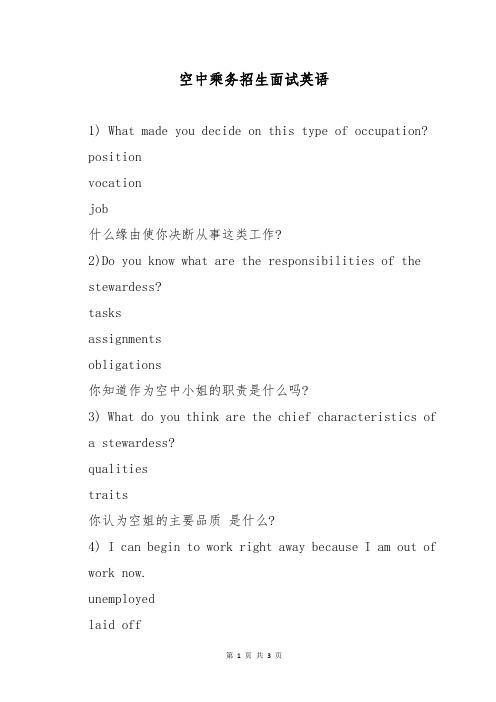
空中乘务招生面试英语1) What made you decide on this type of occupation? positionvocationjob什么缘由使你决断从事这类工作?2)Do you know what are the responsibilities of the stewardess?tasksassignmentsobligations你知道作为空中小姐的职责是什么吗?3) What do you think are the chief characteristics ofa stewardess?qualitiestraits你认为空姐的主要品质是什么?4) I can begin to work right away because I am out of work now.unemployedlaid offbetween jobs我可以即刻开始上班,由于我现在没有工作。
应聘空姐无论是到中国的国际航空公司还是国外的航空公司应聘,公司都要求空中小姐不仅有高挑的身材和甜美的长相,而且要具备优雅的气质,会讲一口流利的英语。
口试内容主要分为中英文面试、中英广播词、航空状况题、时事题、个人问题等。
每一家公司会有不同的考试流程,初复试的难易度也不同,要多方面收集资料,知己知彼,再协作临场应变技能、机敏反应、相宜的装扮、优雅的'谈吐及亲和力,这样面试才能得高分。
BASIC E*PRESSIONS 基本句型表达1) What made you decide on this type of occupation? 什么缘由使你决断投身这个行业呢?2) I like travelling very much and I enjoy working with people.我特别喜爱旅游,喜爱和人打交道。
3) The main responsibility of the stewardess is to make the passengers rela*ed and happy during the flight. 主要的职责就是让乘客在飞行中能放松、欢乐。
中国民航飞行人员英语语言能力测试考试大纲
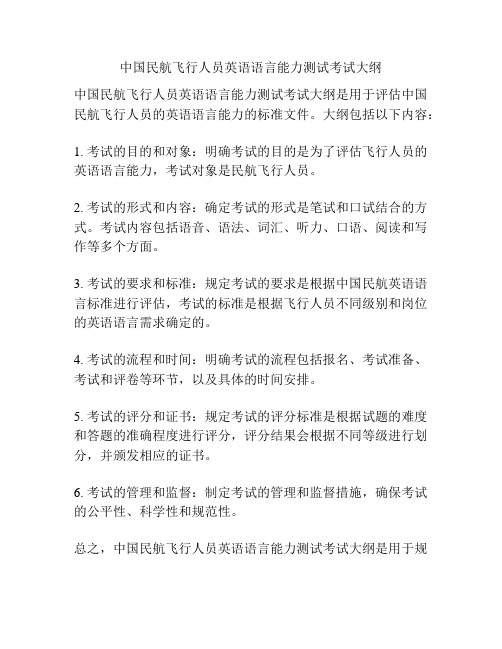
中国民航飞行人员英语语言能力测试考试大纲
中国民航飞行人员英语语言能力测试考试大纲是用于评估中国民航飞行人员的英语语言能力的标准文件。
大纲包括以下内容:
1. 考试的目的和对象:明确考试的目的是为了评估飞行人员的英语语言能力,考试对象是民航飞行人员。
2. 考试的形式和内容:确定考试的形式是笔试和口试结合的方式。
考试内容包括语音、语法、词汇、听力、口语、阅读和写作等多个方面。
3. 考试的要求和标准:规定考试的要求是根据中国民航英语语言标准进行评估,考试的标准是根据飞行人员不同级别和岗位的英语语言需求确定的。
4. 考试的流程和时间:明确考试的流程包括报名、考试准备、考试和评卷等环节,以及具体的时间安排。
5. 考试的评分和证书:规定考试的评分标准是根据试题的难度和答题的准确程度进行评分,评分结果会根据不同等级进行划分,并颁发相应的证书。
6. 考试的管理和监督:制定考试的管理和监督措施,确保考试的公平性、科学性和规范性。
总之,中国民航飞行人员英语语言能力测试考试大纲是用于规
范中国民航飞行人员英语语言能力测试的文件,确保飞行人员具备足够的英语语言能力来应对国际航班和紧急情况。
乘务员英语二级
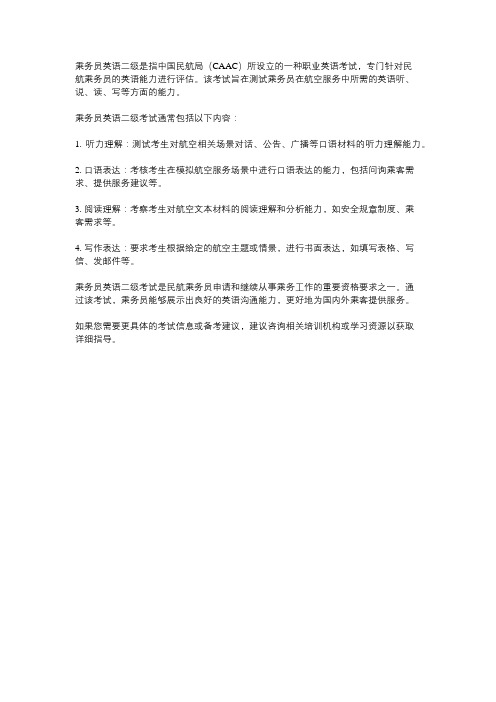
乘务员英语二级是指中国民航局(CAAC)所设立的一种职业英语考试,专门针对民
航乘务员的英语能力进行评估。
该考试旨在测试乘务员在航空服务中所需的英语听、说、读、写等方面的能力。
乘务员英语二级考试通常包括以下内容:
1. 听力理解:测试考生对航空相关场景对话、公告、广播等口语材料的听力理解能力。
2. 口语表达:考核考生在模拟航空服务场景中进行口语表达的能力,包括问询乘客需求、提供服务建议等。
3. 阅读理解:考察考生对航空文本材料的阅读理解和分析能力,如安全规章制度、乘
客需求等。
4. 写作表达:要求考生根据给定的航空主题或情景,进行书面表达,如填写表格、写信、发邮件等。
乘务员英语二级考试是民航乘务员申请和继续从事乘务工作的重要资格要求之一。
通
过该考试,乘务员能够展示出良好的英语沟通能力,更好地为国内外乘客提供服务。
如果您需要更具体的考试信息或备考建议,建议咨询相关培训机构或学习资源以获取
详细指导。
民航乘务英语1-4单元

民航乘务英语1-4单元测试姓名____ 分数____ 一,英译汉(20×2’=40’)1)red-eye flight2)connecting flight3)direct flight4)nonstop flight5)departure time6)one-way ticket7)return ticket8)duty-free shop9)go through security10)Emergency exit seat 11)unaccompanied children12)check in13)an individual set14)go through security15)disabled passengers16)boarding card17)vegetarian18)overhead locker19)call button20)extra weight luggage二,汉译英(10×2’=20’)1)订票,预定2)12点整3)免费的4)填一张表5)护照6)行李7)按8)某人随身带某物9)取下,脱下衣物10)为某某付费三,翻译句子(10×3’=30’)1)Air China Booking Office. Good morning. Can I help you?2)So that’s Flight No.689 with Air China for Hainan at 9:25 a.m. net Wednesday,Sep. 6th, via Nanjing.3)Air China wished you a pleasant trip.4)May I have your ticket and passport?5)Anyone who wants to sit neat the emergency exit has to be over 18 years old.6)I am sorry to say that this flight is delayed for four hours due to bad weather.7)One voucher per person can be used in any of the restaurants near the duty-freeshop.8)Would you mind stepping aside and allowing the other passengers pass?9)I will keep my eye out for it!10)I will handle it with care.四,补全对话(5×2’=10’)A: ________P: Good morning!A: Good morning, madam. ______? I will show you where your seat is. Please go along the aisle. Your seat is on the right by the window.P: Thank you. ________?A: In the overhead locker, please.P: ______A: Under the overhead locker is the call button. _______a.If there is anything we can do for you, please press it.b.Good morning. Welcome aboard.c.Where can I put my hand luggaged.May I see your boarding card, pleasee.OK, thank a lot.。
中国民航管制员 英语等级测试考试大纲
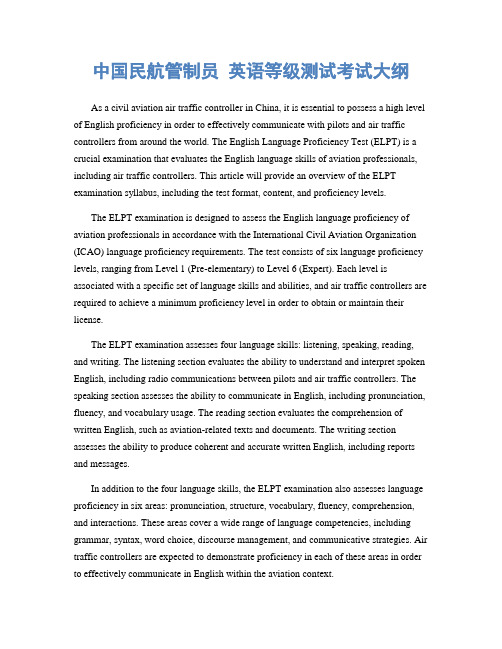
中国民航管制员英语等级测试考试大纲As a civil aviation air traffic controller in China, it is essential to possess a high level of English proficiency in order to effectively communicate with pilots and air traffic controllers from around the world. The English Language Proficiency Test (ELPT) is a crucial examination that evaluates the English language skills of aviation professionals, including air traffic controllers. This article will provide an overview of the ELPT examination syllabus, including the test format, content, and proficiency levels.The ELPT examination is designed to assess the English language proficiency of aviation professionals in accordance with the International Civil Aviation Organization (ICAO) language proficiency requirements. The test consists of six language proficiency levels, ranging from Level 1 (Pre-elementary) to Level 6 (Expert). Each level is associated with a specific set of language skills and abilities, and air traffic controllers are required to achieve a minimum proficiency level in order to obtain or maintain their license.The ELPT examination assesses four language skills: listening, speaking, reading, and writing. The listening section evaluates the ability to understand and interpret spoken English, including radio communications between pilots and air traffic controllers. The speaking section assesses the ability to communicate in English, including pronunciation, fluency, and vocabulary usage. The reading section evaluates the comprehension of written English, such as aviation-related texts and documents. The writing section assesses the ability to produce coherent and accurate written English, including reports and messages.In addition to the four language skills, the ELPT examination also assesses language proficiency in six areas: pronunciation, structure, vocabulary, fluency, comprehension, and interactions. These areas cover a wide range of language competencies, including grammar, syntax, word choice, discourse management, and communicative strategies. Air traffic controllers are expected to demonstrate proficiency in each of these areas in order to effectively communicate in English within the aviation context.The ELPT examination syllabus provides detailed information about the test format, content, and proficiency levels for each language skill and area. It includes sample tasks and performance criteria for each proficiency level, as well as guidelines for test administration and assessment. The syllabus serves as a comprehensive guide for air traffic controllers preparing for the ELPT examination, offering valuable insights into the language requirements and expectations for aviation professionals.In conclusion, the English Language Proficiency Test (ELPT) is a critical examination for civil aviation air traffic controllers in China, as it evaluates their English language skills in accordance with international standards. The ELPT examination syllabus provides a detailed overview of the test format, content, and proficiency levels, offering valuable guidance for air traffic controllers seeking to achieve and maintain the required language proficiency. By mastering the language skills and areas outlined in the syllabus, air traffic controllers can effectively communicate in English and ensure the safety and efficiency of air traffic management in the global aviation community.。
《民航乘务英语(综合)》课程教学大纲
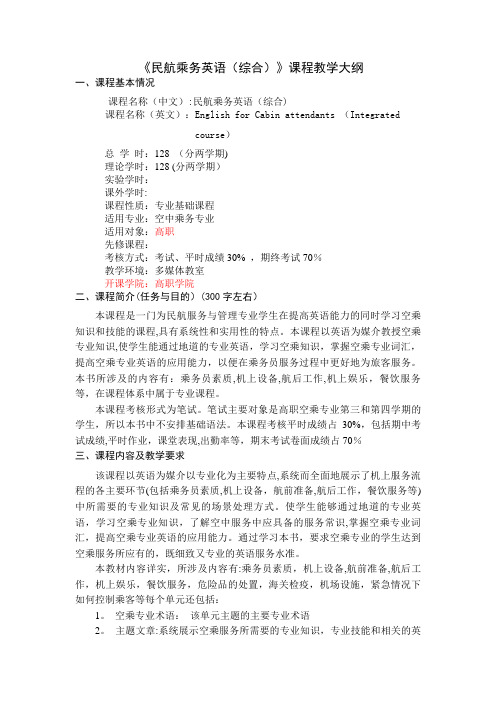
《民航乘务英语(综合)》课程教学大纲一、课程基本情况课程名称(中文):民航乘务英语(综合)课程名称(英文):English for Cabin attendants (Integratedcourse)总学时:128 (分两学期)理论学时:128 (分两学期)实验学时:课外学时:课程性质:专业基础课程适用专业:空中乘务专业适用对象:高职先修课程:考核方式:考试、平时成绩30% ,期终考试70%教学环境:多媒体教室开课学院:高职学院二、课程简介(任务与目的)(300字左右)本课程是一门为民航服务与管理专业学生在提高英语能力的同时学习空乘知识和技能的课程,具有系统性和实用性的特点。
本课程以英语为媒介教授空乘专业知识,使学生能通过地道的专业英语,学习空乘知识,掌握空乘专业词汇,提高空乘专业英语的应用能力,以便在乘务员服务过程中更好地为旅客服务。
本书所涉及的内容有:乘务员素质,机上设备,航后工作,机上娱乐,餐饮服务等,在课程体系中属于专业课程。
本课程考核形式为笔试。
笔试主要对象是高职空乘专业第三和第四学期的学生,所以本书中不安排基础语法。
本课程考核平时成绩占30%,包括期中考试成绩,平时作业,课堂表现,出勤率等,期末考试卷面成绩占70%三、课程内容及教学要求该课程以英语为媒介以专业化为主要特点,系统而全面地展示了机上服务流程的各主要环节(包括乘务员素质,机上设备,航前准备,航后工作,餐饮服务等)中所需要的专业知识及常见的场景处理方式。
使学生能够通过地道的专业英语,学习空乘专业知识,了解空中服务中应具备的服务常识,掌握空乘专业词汇,提高空乘专业英语的应用能力。
通过学习本书,要求空乘专业的学生达到空乘服务所应有的,既细致又专业的英语服务水准。
本教材内容详实,所涉及内容有:乘务员素质,机上设备,航前准备,航后工作,机上娱乐,餐饮服务,危险品的处置,海关检疫,机场设施,紧急情况下如何控制乘客等每个单元还包括:1。
中国民航管制员英语等级测试考试大纲

中国民航管制员英语等级测试考试大纲
中国民航管制员英语等级测试考试大纲主要包括以下几个方面:一、考试目的
本考试旨在评估中国民航管制员的英语水平,确保他们具备足够的英语能力,以适应国际化的航空管制工作环境,确保飞行安全。
二、考试内容
1. 听力理解:通过听力材料,测试考生对英语语言的理解能力,包括语音、语调、词汇、语法等方面的掌握情况。
2. 口语表达:通过与考官的对话,测试考生的口语表达能力,包括发音、流利度、语法、词汇等方面的表现。
3. 阅读理解:通过阅读英文文章或对话,测试考生对英语语言的阅读理解能力,包括获取信息、理解主旨、推理判断等方面的能力。
4. 写作能力:通过写作任务,测试考生的英语写作能力,包括语法、词汇、结构等方面的掌握情况。
三、考试形式
1. 听力理解:通过播放录音材料,考生需在规定时间内完成听力理解题目。
2. 口语表达:与考官进行现场对话,考察考生的口语表达能力。
3. 阅读理解:提供阅读材料或问题,考生需在规定时间内完成阅读理解题目。
4. 写作能力:提供写作任务,考生需在规定时间内完成写作任务。
四、考试时间与地点
1. 考试时间:根据实际情况确定。
2. 考试地点:根据实际情况确定。
五、考试成绩与证书
1. 考试成绩:根据考生的答题情况,给出相应的成绩。
2. 证书:根据考生的考试成绩,颁发相应的英语等级证书。
以上是中国民航管制员英语等级测试考试大纲的主要内容。
考生在备考过程中,应注重提高自己的英语听说读写能力,熟悉考试形式和内容,以便更好地应对考试。
空乘英语面试笔试

空乘英语面试笔试 IMB standardization office【IMB 5AB- IMBK 08- IMB 2C】空乘Hello my name am XX yearsgraduatedfrom have a dream since I was a dream that one day I canfly in the blue sky like the bird. Now I have the chance to make it come true.If i can take this job. I’ll try my best to do everything I lovethis jobHere are good answers to some of thetougher questions asked in job interviews. If you can smoothly supply answerslike these during the interview, you are bound to make a good impression.1. What is important to you in a job?Mention specific rewards other than apaycheck for example, challenge, the feeling of accomplishment, and knowingthat you have made a contribution.2. Why do you want to work for thisorganization?Cite its reputation, the opportunitiesit offers, and the working conditions. Stress that you want to work for thisorganization, not just any organization.3. Why should we employ you?Point to your academic preparation, jobskills, and enthusiasm about working for the firm. Mention your performance in school or previous employment as evidence of your ability to learn and to become productive quickly. If the job involves management responsibilities, refer to past activities as proof of your ability to get along with others andto work as part of a team.4. If we hire you, how long will youstay with us?Answer by saying along these lines:"As long as my position here allows me to learn and to advance at a pace with my abilities."5. Can we offer you a career path?Reply: "I believe you could, once Iknow the normal progression within the organization. Can you tell me about it"The answer may be revealing.6. What are your greatest strengths?Give a response like one of the following:"I can see what needs to be done and do it", "I'mwiling to make decisions", "I work well with others," "Ican organize my time efficiently."7. What are you greatest weakness?Identify one or two, such as thefollowing:" I tend to drive myself toohard", " I expect othersto perform beyond their capacities", " I like to see a job donequickly, and I'm critical if it isn't." Note these weaknesses could alsobe regarded as desirable qualities. The trick with this question is to describe a weakness so that it could also be considered a virtue.8. What didn't you like about previousjobs you've held?Discuss the things you didn't like, butavoid making slighting reference to any of your former employers.9. How do you spend your leisure time?Mention a cross section ofinterests-active and quiet, social and solitary -- rather just one.10. Are there any weaknesses in youreducation or experience?Take stock of your weaknesses before theinterview. Practice discussing them in a positive light. You'll find that they are minor when discussed along with all the positive things you have to offer.11. Where do you want to be five yearsfrom now?Saying that you'd like to be presidentis unrealistic, yet few employers want people who are content to sit still. You might say, "in five years, I'd like to have my boss's job. " If youcan't qualify for your boss's job by then, you may not be the fright candidate.12. What are your salary expectations?If you are asked this at the outset,it's best to say, "Why don't we discuss salary after you decide whetherI'm right for the job "But if the interviewer asks this after showingreal interest in you, speak up. She or he will probably try to meet your price. If you need a clue about what to ask for, say, " Can you discuss yoursalary range with me"13. What would you do if....This question is designed to test yourreposes. For example: "What would you do if your computer broke down during an audit"Your answer there isn't nearly so important as yourapproach to the problem. And a calm approach is best. Start by saying, "One thing I might do is ..." Then give several alternative choices.14. What type of position are youinterested in?Job titles and responsibilities varyfrom firm to firm . So state your skills instead, such as "I'm good atfigure work," and the positions that require these skills , such as "accounts payable."15. Tell me something about yourself.Say you'll be happy to talk aboutyourself, and ask what the interviewer wants to know. If this point is clarified, respond. If not, tell why you feel your skills will contribute to the job andthe organization. This question gives you a great opportunity to sell yourself.16. Do you have any questions about theorganization or the job?Employers like a candidate who isinterested in the organization. so this is a perfect time to convey your interest and enthusiasm..随机咯....不同的老师会问不同的问题...没有特定的....最好自己稍微准备下吧,...我去的时候刚好准备了一份.....也刚好用上...不过这种情况很少....她会根据你填的资料问你一些问题...比如说你的寝室..你的在校生活...你的家乡...还有肯定会问些和航空有关的问题...比如说你对空乘的看法....还有在客舱里要注意些什么之类的...总之你多准备这方面的内容吧...都是些简单的问题....放轻松了...别紧张...祝你幸运.......2.英语笔试有两套卷子难易程度不同看你的运气了口试的要看你先说什么了3.考官会先让你自我介绍然后根据你说的方向会提一些问题最好做些基本的准备比如你为什么会选择这个职业你的家人对你这个选择的看法是否支持你认为你相比他人而言优势有哪些如果这次没有入选你对将来有何打算(本人就自己的经验而谈,希望能有帮的上你)英语——服务(service)1、您想看这些报纸或杂志吗Would you like to read these news papers or magazines2、您想先喝点什么Would you like anything to drink first3、这是今天的菜单,你想吃些什么Here is today''s menu.What would you like to have4、谢谢,让您久等了。
- 1、下载文档前请自行甄别文档内容的完整性,平台不提供额外的编辑、内容补充、找答案等附加服务。
- 2、"仅部分预览"的文档,不可在线预览部分如存在完整性等问题,可反馈申请退款(可完整预览的文档不适用该条件!)。
- 3、如文档侵犯您的权益,请联系客服反馈,我们会尽快为您处理(人工客服工作时间:9:00-18:30)。
中国民航英语工程乘务英语考试大纲(试行)中国民航总局2001年10月第一章考试总则第一节考试性质民航乘务专业英语考试是由中国民用航空总局组织, 对民航系统内乘务人员的正规英语水平考试.第二节考试目的民航乘务人员的英语水平直接影响着中国民航的服务质量, 影响着中国民航的对外形象, 民航乘务专业英语考试的目的是用考试的方法促进民航乘务人员英语水平的提高, 也为各航空公司安排乘务工作时提供考察乘务人员英语水平的参考依据.第三节考试对象民航乘务专业英语考试的对象是中国民航系统内的在职乘务人员以及高校乘务专业的毕业学生.第四节考试内容民航乘务专业英语考试的内容涉及乘务员素质、机上设施、航前航后准备、机上娱乐、餐饮服务、危险品处置、客舱服务、紧急情况处理、机场设施、海关、检疫等方面的知识。
语言范围主要是基础知识. 内容如下:1.各级考生需掌握的相关的阅读和听说的词汇量. 分别为:初级------2000/1500中级------3500/25002.语音语调基本正确。
3.词法:某些词的词形变化、各类词的作用和构成.4.句法:简单句、并列句、复合句及各种从句。
5.动词:动词的基本时态、非谓语动词(不定式、动名词、现在分词、过去分词)的形式及其作用。
6.形容词和副词的三种级别的用法。
7.虚拟语气。
第五节考试重点一.理解能力1.能正确理解原文, 掌握所读材料的主旨和大意.2.根据所读材料进行一定的判断, 推理和引申.3.既理解个别句子的意义, 又理解上下文之间的逻辑关系.4.领会作者的观点和态度.5.能根据原文正确做出各种练习.二.运用能力1.能正确运用自己的基础知识完成各类试题.2.能听懂考试要求内容并能正确表达自己的观点.第六节考试等级民航乘务专业英语考试根据考试重点和难度设两个等级: 初级和中级.第七节考试形式民航乘务专业英语考试的两个等级均设笔试, 听力, 口试三种形式. 各级的具体考试形式如下:一. 笔试(100分)初级考试:100分1. 词汇句法题量20句. (20%)2.阅读理解题量4段20题. (40%)3.完形填空题量10个空(20%)4.英译汉题量8句(20%)中级考试:100分1. 词汇句法题量20句. (20%)2.阅读理解题量4段20题. (40%)3.完形填空题量10个空(20%)4.英译汉题量8句(20%)二.听力与口语(100分)I.听力初级考试:60分1.辨音数字题量10个音标.(10%)2.单句选择题量10句. (10%)3.简单对话题量10段. (20%)4.短文题量2篇10题(20%)中级考试:60分1.数字题量10个. (10%)2.单句选择题量10个. (10%)3.简单对话题量10个. (20%)4.简单文章题量2段10题(20%)II.口语初级考试:40分1.自我介绍(5分)2.广播词朗读题量1段(15分)2.简单对话题量10题(20分)中级考试:40分1.自我介绍(5分)2. 按要求编播广播词题量1段. (15分)3.回答问题题量8个(20分)第八节考试用时一.笔试初, 中级两个级别笔试的规定时间均为90分钟. 二.听力初级听力考试的规定时间为30分钟.中级听力考试的规定时间为30分钟.三.口试初级口试的规定时间为20分钟.中级口试的规定时间为20分钟.第九节考试方法初、中级的笔试均为书面答题. 所在答案必须写在答题纸上.听力为听录音并书面答题, 均需将答案写在答题纸上.口试均采用人机对话的方式进行.第十节阅卷每次考试结束后,由总局人教司或人教司委派某管理局科教部门监督阅卷。
在阅卷监督人员没到场时,主考单位不得将考生试卷袋打开。
第十一节考试记分无论考生参加那一级的考试,均需完成各级的笔试、听说二种形式的考试。
各项考试分分别为100分,即:笔试为100分, 听说为100分.考生要在笔试、听说成绩分别达到60分以上(听说考试中口语成绩不能低于20分)者为合格.第十二节考试结果每次考试结束后,主考单位应及时组织阅卷,并将成绩上报总局,最迟不得超过一个月,如有特殊原因应及时向总局人教司报告。
主考单位无权向考生和考生单位通报考试结果。
凡通过中级考试的考生,由民航总局人教司向其颁发相应的证书,证书有效期为5年.第十三节考试时间考试每年1月和7月各举行一次, 具体时间由民航总局人教司确定.根据各公司的培训和工作情况,需要在总局所规定考试时间以外安排考试的单位,应向总局人教司提出口头或书面申请,经总局人教司批准后,通知主考单位安排落实。
第十四考试地点各级考试的考场均设在中国民航学院(天津), 在考生较集中的单位,可由单位向主考单位申请设立分考场.第十五节考试命题各级考试题均由计算机随机命题. 在民航总局人教司的负责人员监督下, 开机提取, 编辑加工, 封闭印刷, 装订成册后全部密封备用.第十六节题库各级题库均以计算机软盘方式保存, 由民航总局人教司指定专人保存, 任何人不得复制.ENGLISH PROFICIENCY TESTFOR FLIGHT ATTENDANTS(LISTENING TEST)PART 1 Number IdentificationDIRECTIONS: In this part, you will hear 10 sentences. Each sentence contains one of the four numerical phrases marked A, B, C, and D given to you. Listen carefully and choose the right phrase, then mark it on your ANSWER SHEET.1. A.9418 C. 1948B. 9148 D. 91842. A.$49.99 B. $49.89C. $39.99D. $39.893. A. 8:25 C. 8:55B. 8:35 D. 8:454. A. 1726 B. 2762C. 1762D. 70625. A. 8 C. 800B. 80 D. 186. A. 001-232-5220 B. 010-232-5202C. 010-223-5202D. 001-223-52027. A.35-38 B. 34-39C. 35-39D. 34-388. A. 147,361,000 B. 14,736,100C. 1,473,610D. 147,3619. A. Sept. 13th…6th B. Sept.13th… 16thC. Oct. 13th… 6thD. Oct. 13th…16th10. A. CPG332T B. CPG323CC. CPG323TD. CPG332CPART 2 StatementsDIRECTIONS: In this part, you will hear 10 statements. To each statement, there are 4 choices printed on your test paper marked A, B, C, and D, only one of which, however, is closest in meaning to the sentence you've heard. Listen carefully, choose the one you think correct, and mark it on your ANSWER SHEET.EXAMPLE:You will hear: The flight leaves at 5:15 p.m.You will read: A. It leaves in the morning.B. It leaves in the afternoon.C. It leaves at 4 o'clock in the morning.D. It leaves at night.Sentence B. "It leaves in the afternoon." is closest in meaning to statement "The flight leaves at 5:15 p.m." Therefore, you should choose answer B, and mark it on your ANSWER SHEET.11. A. You enjoyed the lecture too, didn't you?B. I don't care for her lectures, do you?C. Her lecture was on a serious topic.D. She enjoys giving lectures.12. A. I don't want to see Jeff.B. At last Jeff wants to see me.C. Jeff was the last person to see me.D. I want to see Jeff least13. A. The passengers are satisfied with the service.B. The passengers are not satisfied with the service.C. The cabin attendants are very helpful on this flight.D. The passengers are very grateful to the cabin attendants on the flight .14. A. She is leaving by car.B. She is leaving by train.C. She is leaving by sea.D. She is leaving by plane.15. A. He lives in a warm climate.B. He doesn't live in a warm climate.C. He lived in a warm climate.D. He lives in a hot climate.16. A. The Martins visited us.B. We visited the Martins.C. The Martins were very busy.D. We didn't have time to visit the Martins.17. A. About a half hour before departure, the passengers begin boarding.B. About an hour before departure, the passengers begin boarding.C. Around an hour before departure, the passengers begin checking-in.D. Around a half hour before departure, the passengers begin check-in.18. A. Jane is feeling a sharp pain in her eyes.B. Jane has got a sharp ache in her legs.C. Jane has got a slight pain in her head.D. Jane has got a slight ache in her legs.19. A. The toilets are very clean.B. The toilets are very dirty.C. The toilets are occupied.D. The toilets are empty.20. A. You have a more selection of drinks on a plane.B. You have a good selection of drinks on a plane.C. You have a less selection of drinks at a bar.D. You have a good selection of drinks at a bar on the ground.PART 3 ConversationsDIRECTIONS: In this part, you will hear 10 short conversations. At the end of each conversation, a question will be asked about it. To the question you've heard, there are four possible answers printed on your test paper and marked with A, B, C, and D. Listen carefully, choose the best answer, and mark it on your ANSWER SHEET.EXAMPLE:You will hear: M: Excuse me, Miss. Would you please show me where my seat is?W: Your boarding pass, please. Your seat number is 15A, on the left side of the aisle. This way, please.Q: Where does this conversation most probably take place?You will read: A: In a restaurant. B. In a theater.C: On an airplane. D. In a waiting-room.From the conversation we know this talk is between a stewardess and a passenger, which is most likely to have taken place on an airplane. Therefore, "C. on an airplane" is the best answer. You should choose answer "C", and mark it on your ANSWER SHEET.21. A. Well-mannered. C. Good-looking.B. Good-humored. D. Intelligent.22. A. He likes bananas. C. He can only afford bananas.B. He wants nothing but bananas. D. He wants to lose some weight.23. A. A new suit. C. A new skirt.B. A new shirt. D. A pair of new shoes.24. A. Mrs. Smith's. C. Mrs. Morgan's.B. Mr. Smith's. D. Mr. Morgan's.25. A. He has only seen a Boeing 747 on TV.B. There is a TV set on the Boeing 747.C. He only watches TV.D. He likes watching TV on a Boeing 747.26. A. French dressing. C. Fresh dressing.B. Thousand Island dressing. D. Salad dressing.27. A. He isn't sure, but he'll try his best.B. He is sure to get there on time.C. He promises to get there on time.D. He can be there on time.28. A. The captain can't come.B. She hopes the captain won't comeC.. She thinks the captain will be on time.D. The captain will be late.29. A. If the cocktail service is very close to meal service.B. When drinks are served.C. When the cabin attendants are busy.D. When the meal service is served.30. A. Pick up the chair. C. Remain standing.B. Sit down at once. D. Leave in a minute.PART 4 PassagesDIRECTIONS: In this part, you will hear 2 passages, each followed by 5 questions. To each question, there are 4 possible answers marked with A, B, C, and D. You are to choose the correct one and mark it on your ANSWER SHEET.Questions 31 to 35 are based on the following passage:31. A. At 11:00 B. At 1:00C. At 11:25D. At 2:0032. A. At 1:00 B. At 11:00C. At 11:35D. At 11:2533. A. It's just behind the international terminal.B. It's just beside the international terminal.C. It's just in the front of the international terminal.D. It's just on the opposite of the international terminal.34. A. When does he have to reconfirm his reservation before he returns?B. Where does he reconfirm his reservation?C. How does he reconfirm his reservation?D. Who will help him to reconfirm his reservation before he returns?35. A. He should do it 72 hours before.B. He should check with the information counter in the arrival lobby.C. He should ask for the ground attendants.D. He should do it 3 days before.Questions 36 to 40 are based on the following passage:36. A. Because a modern airline pilot has to follow set routes and keep to a rigid schedule.B. Because flying is not as much fun as it used to be.C. Because everything a pilot does is governed by instruments.D. Because a pilot has to obey regulations.37. A. He has the responsibilities to obey the rules.B. He is responsible for all the instruments on board.C.. He is responsible for the aeroplane and the passengers.D. He has the responsibilities to look after all the crew members38. A. Because the aeroplane was smaller.B. Because the pilot was more able.C. Because a pilot had more experience.D. Because a pilot was free to go where he liked, when he liked.39. A. He could follow a railway line.B. He could land in a convenient field to ask the way.C. He could rely on his own experienceD.. Both (A) and (B)40. A. They spend much of their spare time reading about old aircraft or even rebuilding andflying them.B. They spend a lot of time talking about the good old days.C. They buy models of old aeroplanes.D. They like flying old aeroplanes.ENGLISH PROFICIENCY TEST FOR FLIGHT ATTENDANTS(ORAL TEST)PART 1 Self-IntroductionDIRECTIONS: In this part, within 2 minutes, you are required to make self-introduction about your occupation, your family, your hobbies and so forth.PART 2 AnnouncementsDIRECTIONS: In this part, you are required to make announcements according to the given clue within 2 minutes. Read it aloud in a professional way.The plane is delayed, because connecting passengers haven’t boarded the plane. Inform the passengers on board.PART 3 Free TalkDIRECTIONS: In this part, you are required to answer 8 questions you’ve heard on the tape.ENGLISH PROFICIENCY TESTFOR FLIGHT ATTENDANTS(WRITTEN TEST)PART 1 Vocabulary & StructureDIRECTIONS: In this part, there are 20 incomplete sentences. Each of them is followed by four possible choices marked with A, B, C, and D. You are required to choose the correct or best one to complete each sentence. Mark it on your ANSWER SHEET.1. The physical examinations are required ______ for all flight service personnel.A. at timesB. in the event of an emergencyC. once in a life timeD. periodically2. Of all the duties that the stewardess performs on board, the one that occupies the greatestamount of her time is ______.A. helping passengers locate their seatsB. serving food and drinks to the passengersC. explaining the use of the passenger service unitD. making life jacket and oxygen mask demonstrations3. ______ of your safety, please fasten your seat belt.A. The sakeB. For the sakeC. With the sakeD. To the sake4. Often the cabin attendants report ______ , which means that the equipment is not workingproperly to the flight engineer.A. faulty equipmentB. service mistakeC. galley procedureD. purser's log5. I'm sorry but I must ask you to stop smoking because ______.A. it is safeB. for the sake of safetyC. of safety is concernedD. it is a matter of safety6. The plane is ______ when it is taken over by people with weapons, such as guns, knives,explosives, ect.A. on fireB. hijackedC. diverted to an alternateD. sprayed against insects7. Sometimes if none of the stewardesses can speak a passenger's language , it is possible______.A. not to serve him at allB. to communicate with him by writingC. to get help from another passengerD. not to keep him informed8. It is ______ to use the walkman during the flight according to the CAAC regulations.A. allowedB. prohibitedC. requiredD. expected9. Can I offer you ______, sir?A. to read somethingB. something to readC. to read anythingD. anything reading10. Jet stream can increase the speed of the plane flying ______.A. north to southB. south to northC. west to eastD. east to west11. My friend did not know _______ or not he passed the exam.A. whetherB. ifC. whyD. when12. Public television stations are different from commercial stations _______ .A. because they receive money differently and different types of showB. for money and program typesC. in the areas of funding and programmingD. because the former receives money and has programs differently from the latter13. She is ______ age ______ her workmate.A. same...asB. same...ofC. the same...ofD. the same...as14. My goodness, look at the time! It's nine o'clock ______ and I'm ______ at breakfast.A. already...yetB. yet... stillC. still...alreadyD. already...still15. Jane, as well as Alice and Martha, ______ nursing at the Queen College.A. is studyingB. are studyingC. were studyingD. has been study16. She wanted to serve some coffee to her guests; however,________ .A. she hadn't many sugarB. there was not a great amount of the sugarC. she did not have much sugarD. she was lacking in amount of the sugar17. The movie that we saw last week was quite interesting, ________A. wasn't it?B. was it?C. didn't it?D. weren't we?18. Tom said that no other car could go _______.A. so far like his car C. as fast like the car of himB. as fast like his car D. as fast as his car19. Can you see that man ______ a blue coat ______ a pair of glasses ______ his face?A. with ... with...inB. in...with...onC. in...on...onD. in...in...on20. His ideas were far ______ the age in which he lived.A. in front ofB. in advanceC. at an advantageD. in adventure ofPART 2 Reading ComprehensionDIRECTIONS: In this part, there are 3 passages. Each of them is followed by 5 questions, and to each question, there are four possible answers marked with A, B, C, and D. Please choose the correct or best answer to each question and mark it on your ANSWER SHEET.Questions 21 to 25 are based on the following passage:Ever since humans have inhabited the earth, they have made use of various forms of communication. Generally, this expression of thoughts and feeling has been in the form of oral speech. When there is a language barriers communication is accomplished through sign language in which motions stand for letters, words, and ideas. Tourists, the deaf, and the mute have had to resort to this form of expression, many of these symbols of whole word are very picturesque and exact and can be used internationally; spelling, however, cannot.Body language transmits ideas or thoughts by certain actions, either intentionally or unintentionally. A wink can be a way of flirting or indicating that the part is only joking. A nod signifies approval, while shaking the head indicates a negative reaction.Other forms of nonlinguistic language can be found in Braille(a system of raised dots read with the fingertips), signal flags, Morse code, and smoke signals. Road maps and picture signs also guide, warn, and instruct people.While verbalization is the most common form of language, other system and techniques also express human thoughts and feelings.21. Which of the following best summarizes this passage?A. Although other forms of communication exist, verbalization is the fastest.B. Everybody uses only one form of communication.C. Nonlinguistic language is invaluable to foreigners.D. When language is a barrier, people will find other forms of communication.22. Which of the following statements is not true?A. The deaf and mute use an oral form of communication.B. Verbalization is the most common form of communication.C. There are many forms of communication in existence today.D. Ideas and thoughts can be transmitted by body language.23. Which form other than oral speech would be most commonly used among blind people?A.. Braille. C. Body language.B. Picture signs D. Signal flags.24. How many different forms of language are mentioned here?A. 9 C. 5B. 7 D. 1125. Sign language is said to be very picturesque and exact and can be used internationally exceptfor ______.A. expression C. whole wordsB. ideas D. spellingQuestions 26 to 30 are based on the following passage:Hotels for MotoristsThe first hotels were very different from today's hotels. They were small inns built along the road. Later, as people began to travel by train, hotels were built in the centers of large cities. Usually near rail-road stations, these hotels were many stories tall and had hundreds of rooms.Although trains were a popular means of travel for some time, automobiles slowly began to take their place. Automobile travel caused problems for city hotels, which did not have parking space for so many cars.People who traveled by automobile needed a different kind of hotel. They needed places to stay that were near highways and had room to park. Motorists did not like to drive in heavy city traffic to reach a hotel. The answer to the motorists' problems came when a new kind of hotel was built. These new buildings were called motels, a word made from the first part of MOTORIST and the last part of HOTEL.Motels were much smaller than hotels. Built on ground level, often in separate units, they were more convenient for people traveling. The separate units also made them quieter than hotels. Best of all, there was more than enough room for cars to park.Now, many big hotels in the cities are being torn down. They can no longer make enough money to stay in business. In their place, many small motels have been built on the outskirts of cities. Motels have become a big business in the United States.26. The first hotels were built ______.A. with hundreds of rooms.B. around the city centers.C. not far away from roads.D. near railway stations.27. Hotels became less popular because they usually did not have _______.A. a place for cars to park inB. large enough rooms for big families.C. sufficient ground rooms.D. quiet and convenient units.28. Motels are usually _______.A. large, high buildings built in the downtown area.B. small, low buildings built along highways outside the city.C. small, high buildings built on the outskirts.D. large, low buildings built around city center.29. The reason why many big hotels are being torn down is that _______.A. it costs too much money to stay in a hotel.B. people need the materials to build small motels.C. they are losing their competition to motels.D. cities are usually short of land for building motels.30. On the whole, this passage is about ______.A.. the reason why a new kind of hotel came into being.B. motorists' problems out on the highwayC. which place is better for people to stay for the night.D. how to find a place to park your car during travel.Questions 31 to 35 are based on the following passage:The flight service crew members should always deal with the passengers and with each other in a professional and dignified manner. It is necessary to avoid excessive familarity with passengers. The cabin crew must also pay careful attention to their personal appearance during the flight. The airlines consider good grooming to be representative of the flight attendants' good will and personal pride.When the cabin crew is making its periodic checks, the passengers will often have questions about service, schedules, routes, and weather. The cabin attendants try to answer these questions pleasantly, and they should avoid airline jargon with which the passengers may not be familiar. In addition to making the regular cabin checks, the attendants should answer call buttons promptly and courteously.The cabin attendants are also responsible for the neatness and cleanliness of the passenger cabins. They keep the cabin, the lavatories, and the galleys clean at all times and clear of briefcases, purses, galley equipment, and so on. Cabin attendants report any item of equipment that is not working properly to the flight engineer.31. How should the flight service crew deal with the passengers and with each other?A. In a professional and dignified manner.B. In a dignified manner.C. In a good manner.D. In a professional manner.32. Why do the cabin crew pay careful attention to their grooming during the flight?A. Because every airline requires the flight attendants do so.B. Because it represents the flight attendants' good will and personal pride.C. Because passengers like it.D. Because the flight attendant likes to do so.33. How do the cabin attendants answer the passengers questions?A. Promptly. C. Quickly.B. Courteously. D. Pleasantly.34. What must be kept neat and clear of briefcases ?A. All the above. C. Lavatories.B. Galleys. D. Cabin.35. Which of the following statements is not true?A. The cabin attendants report any item of equipment which is not working properly to thepilot.B. The cabin attendants should answer call buttons promptly and courteously.C. The cabin attendants are responsible for the cleanliness of the galleys.D. The cabin attendants should avoid airline jargon when they answer passengers' questions.Questions 36 to 40 are based on the following passage:There are standards of grooming for each airline, and they are clearly stated. There are differences from one company to another, but the general rules apply to most, since this is a major grooming concern. The important thing is that there should be an attractive, simple style reflecting current fashion. Extremes are to be avoided, as are styles that would interfere with proper wearing of the hat. The style must be maintained; if a stewardess does not have the time to do this properly, she must choose a more manageable style.Hair length is a matter of individual preference. The length should look well with the uniform, and it should suit the wearer. The hair may not be worn long and loose. It should not fall forward on to the face while serving meals and drinks. If hair is long enough to be tied back, it must be worn in a George Washington, a chignon, or some other contemporary style.36. If a stewardess does not have time to maintain her hair,_____________ .A. she must choose a more manageable styleB. it must be worn in a George WashingtonC. it must be fastenedD. it should suit the wearer37. The passage tells us something about _________ .A. how to become a stewardessB. groomingC. hat wearingD. general rules for stewardess38. What are the general guidelines for hairstyle?A. An attractive, simple style reflecting current fashion.B. Fashionable and extreme style.C. Old style.D. Short hair style.39. According to the passage which of the following statements is not true?A. Hair style is a matter of individual matter.B. Different airline has different guidelines for hair style.C. Hair may not be worn long and loose.D. If hair is long enough, it must be tied up.40. Why shouldn't hair be worn loose and long?A. Because it doesn't look fine.B. Because it is hard to control.C. Because it would interfere with serving meals and drinks.D. Because it would take much time to manage.PART 3 Cloze TestDIRECTIONS: In this part, the words and phrases are missing in the following paragraph. Choose the most appropriate from the words and phrases marked with A, B, C, and D, and mark it on your ANSWER SHEET.The price of hotels in Britain is going up 41 at any time since the war. There are a number of reasons for this but the 42 all is the Government’s economic policy. Managers in factories see 43 so they are attracted to the idea of owning 44 businesses. 45 Britain’s weather is often disappointing, the tourist industry is growing. Many people 46 like to combine a 47 holiday with the opportunity of improving their English. It is therefore not surprising that businessmen are buying hotels. The only thing 48 worries me is the kind of treatment their guests are 49 to receive since 50 of them know anything about hotel management.41. A. more fast than B. more fast than C. faster than D. more faster than42. A. most important of B. more important ofC. most important fromD. more important from43. A. to fall their standard of living B. falling their standard of livingC. their standard of living to fallD. their standard of living falling44. A. his proper B. his own C. their proper D. their own45. A. In spite of B. Although C. Even D. However46. A. in the Continent B. in the overseas C. abroad D. foreign47. A. fortnight B. fortnight’s C. two weeks D. two week’s48. A. that B. what C. as D. who49. A. like B. probable C. probably D. likely50. A. little B. a little C. few D. a fewPART 4 TranslationDIRECTIONS: In this part, there are seven sentences written in English. Translate these sentences into Chinese.51. Each airline flies specific routes, and each stewardess must be familiar with the routes and withthe cities that are served by the airline she represents.52. The way stewardesses dress and look may often determine whether a customer will choose tofly on that airline again.53. The flight service crew members should always deal with the passengers and with each other ina professional and dignified manner.54. New technological developments in recent years have simplified the operation, and now themechanical aspects of the film-showings are relatively simple and trouble-free.55. Each crew member, whether he or she works in the galley, the cabin, or the cockpit, has certainduties to perform, and these must be coordinated with those of the rest of the crew.56.I’ll give you whatever support I can within my ability.57.There is no denying the fact that the new management method has greatly increased theproduction.58.All living languages are characterized by sound changes that have occurred and will continue tooccur in the course of their history(注:文档可能无法思考全面,请浏览后下载,供参考。
